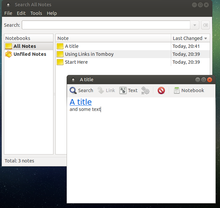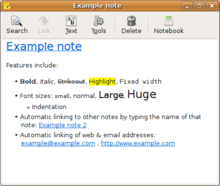 | |
 Tomboy 1.15.4 running on Ubuntu MATE | |
| Developer(s) | Alex Graveley and Tomboy Contributors |
|---|---|
| Stable release | |
| Repository | github |
| Written in | C# |
| Operating system | Windows, macOS, Linux, BSD |
| Platform | Mono |
| Type | Notetaking software |
| License | LGPL-2.1-only[3] |
| Website | projects |
Tomboy is a free and open-source desktop notetaking app written for Windows, macOS, Linux, and BSD operating systems. Tomboy is part of the GNOME desktop environment. As Ubuntu changed over time and its cloud synchronization software Ubuntu One came and went, Tomboy inspired various forks and clones. Its interface is a word processor with a wiki-like linking system to connect notes together. Words in the note body that match existing note titles become hyperlinks automatically, making it simple to construct a personal wiki. For example, repeated references to favorite artists would be automatically highlighted in notes containing their names. As of version 1.6 (2010), it supports text entries and hyperlinks to the World Wide Web, but not graphic image linking or embedding.
Development of the original Tomboy software ceased in 2017. Starting in 2017 the development team rewrote the software from scratch, for ease of maintenance and installation, renaming it tomboy-ng.[4] Tomboy-ng is written in Free Pascal.[5]
YouTube Encyclopedic
-
1/5Views:82 8147 06637241353 040
-
The BEST Private Notetaking Apps Explained
-
How to use Tomboy Notes in writing a research report
-
Molinux 4.2 - Tomboy
-
Tomboy Note Sharing - Novell Hack Week
-
Cherrytree Notes Review
Transcription
Features

Some of the editing features supported:
- Text highlighting
- Inline spell checking using GtkSpell
- Automatic hyperlinking of Web and email addresses
- Undo/redo
- Font styling and sizing
- Bulleted lists
- Note synchronization over SSH, WebDAV, Ubuntu One, or the Tomboy REST API[6] that is implemented by several server applications
Plugins
Tomboy supports several plugins, including:
- Evolution mail links
- Galago/Pidgin presence
- Note of the day (disabled by default)
- Fixed width text
- HTML export
- LaTeX math (in the package tomboy-latex, not installed by default)
Ports
- Conboy: a Tomboy port to the Maemo platform written in the C language[7][8]
- Gnote: a conversion of the Tomboy code to the C++ language, but is not cross-platform
- libktomgirl: a platform-independent library that reads and writes the Tomboy File Format[9]
- Tomdroid: an effort to produce a Tomboy-compatbile notetaking app for the Android operating system.[10][11]
See also
References
- ^ "tomboy: Tomboy Notes". Retrieved 1 January 2018.
- ^ "Release 1.15.9". 16 July 2017. Retrieved 15 November 2020.
- ^ "tomboy_1.14.1-4_copyright".
- ^ "GNOME Wiki: tomboy-ng". Retrieved 12 October 2022.
- ^ "tomboy-ng wiki: Building tomboy-ng". GitHub. Retrieved 12 October 2022.
- ^ "Tomboy Web, A RESTful API for Tomboy Note Synchronization". 2014-08-23. Retrieved 2014-09-13.
- ^ Conboy
- ^ "garage: Conboy - Note Taking Application: Project Info". September 16, 2009. Retrieved September 16, 2009.
- ^ "libktomgirl: An implementation of the Tomboy File Format in C++". GitHub. October 15, 2013. Retrieved October 15, 2013.
- ^ Tomdroid
- ^ "Tomboy Notes on Android: Olivier Bilodeau Releases Tomdroid 0.1.0". April 21, 2009. Retrieved January 3, 2010.
